
ChatGPT is an AI text generator like no other. It’s the new major leap in the AI takeover.
The best part about ChatGPT is that it’s free at the moment. This might change in the very near future, though.
This time, the AI is not only capable of producing text but also writing code and helping programmers understand code. Besides, it can write books, lyrics, blog posts, and such.
Speaking of blog posts, read How to Write Blog Posts with ChatGPT.
Even though the tool is impressive and seemingly could replace coders and content creators, it still has a lot of question marks.
For example, ChatGPT has a tendency to provide users with inaccurate data in a convincing manner. Besides, it repeats itself and doesn’t know answers to questions of events after 2021.
AI is coming, but it still needs to improve!
This is a complete review of the AI writing tool called ChatGPT by OpenAI.
💡 Make sure to read my comprehensive guide to the Best AI Writing Software.
Let’s jump into it!
What Is ChatGPT?
In simple terms, ChatGPT is a computer program that is designed to generate text that is similar to how a human might write or speak. It does this by using a large dataset of human-generated text as a reference and using machine learning techniques to learn the patterns and structure of this text.
When given a prompt or input, ChatGPT can generate a response that is appropriate and fits naturally within the context of the conversation.
This makes it useful for building chatbots that can engage in natural-sounding conversations with users. ChatGPT is a variant of the GPT language model, which was developed by OpenAI.
How Does ChatGPT Work?
Notice that you don’t need to understand how ChatGPT works on a technical level to use it. But for some of our readers, this information might be insightful so I’m sharing it here—technical terms alert!
AI writing models, such as ChatGPT, work by using machine learning algorithms to analyze and learn from a large dataset of human-generated text.
This dataset is used to train the model on the patterns and structures of the language used in the text, as well as the meanings and relationships between words and phrases.
Once the model has been trained, it can be used to generate new text by predicting the most likely words or phrases to follow a given prompt or input.
The model uses the patterns and structures it has learned from the training data to guide its predictions and generate text that is similar in style and structure to the training data.
There are different techniques that can be used to build AI writing models, including natural language processing (NLP) and machine learning algorithms such as neural networks.
- NLP focuses on the interaction between computers and human language. It involves techniques for analyzing, understanding, and generating natural language.
- A neural network is a machine learning algorithm that is inspired by the structure and function of the human brain. A neural network is capable of learning and making predictions based on large datasets.
On a low level, these machine learning models are just a whole bunch of code and mathematics similar to any other computer program. But these models are coded in a way that they can improve themselves.
AI writing models can be used to generate a wide range of written content, including articles, stories, and even poetry. The state of the art in AI writing at the moment is that the tools are impressive but still need human intervention.
To learn more about AI, make sure to read What Is Artificial Intelligence.
My Experience with ChatGPT
In this section, I show you how easy it is to use ChatGPT and what types of use cases there are.
ChatGPT Remembers
ChatGPT is able to remember earlier messages in a conversation and use this context to generate appropriate responses. It takes into account the entire history of a conversation and uses it to generate appropriate responses.
Tip: ChatGPT word limit is 500. This means a message cannot be longer than 500 words.
If your message is cut short, just send “continue” and ChatGPT will continue exactly from where it left.
Here’s an example that demonstrates how ChatGPT remembers earlier messages in the chat.
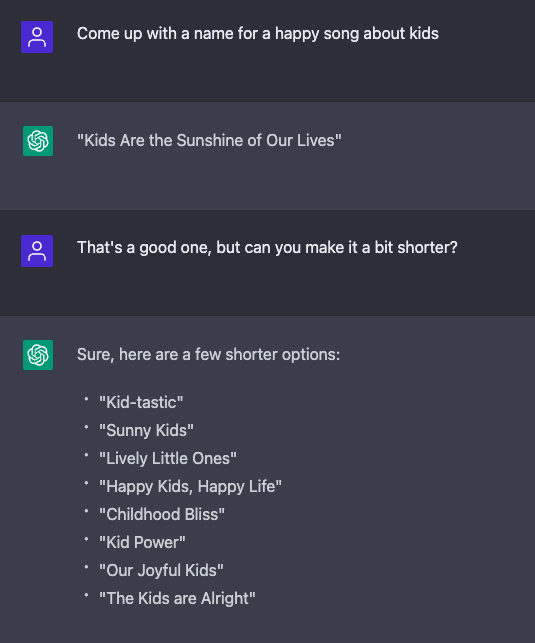
Here you can see that my second message has nothing to do with anything unless the bot knows what we talked about earlier. This shows how ChatGPT remembers earlier messages.
This can be useful when you’re writing e.g. a blog post or similar. At the end of the conversation, you can ask ChatGPT to summarize the entire thread into a concluding paragraph, for example.
Blog Post
An obvious use case for ChatGPT AI is to use it for writing long-form content such as blog posts or articles.
For example, here I ask ChatGPT to come up with a blog post outline for a blog post about Santa Claus.
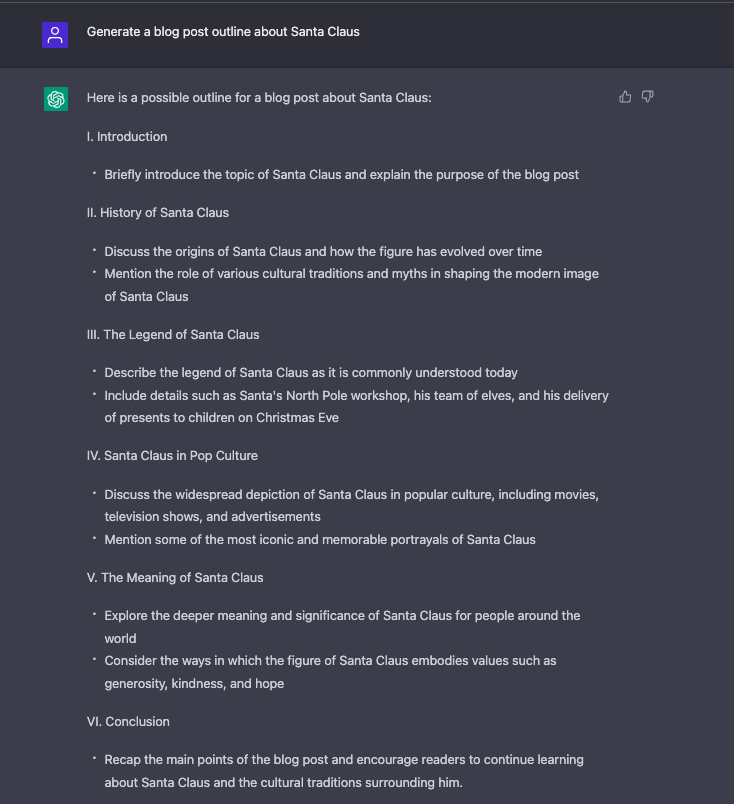
As an experiment, I actually wrote out a post with ChatGPT. You can check the result here—a 2,500-word blog post entirely written by AI.
[mc4wp_form id=1660]
Code
But hey, AI isn’t impressive as long as it doesn’t write code, right? Well, ChatGPT writes code too.
For example, here I asked ChatGPT to demonstrate what are classes in Python:
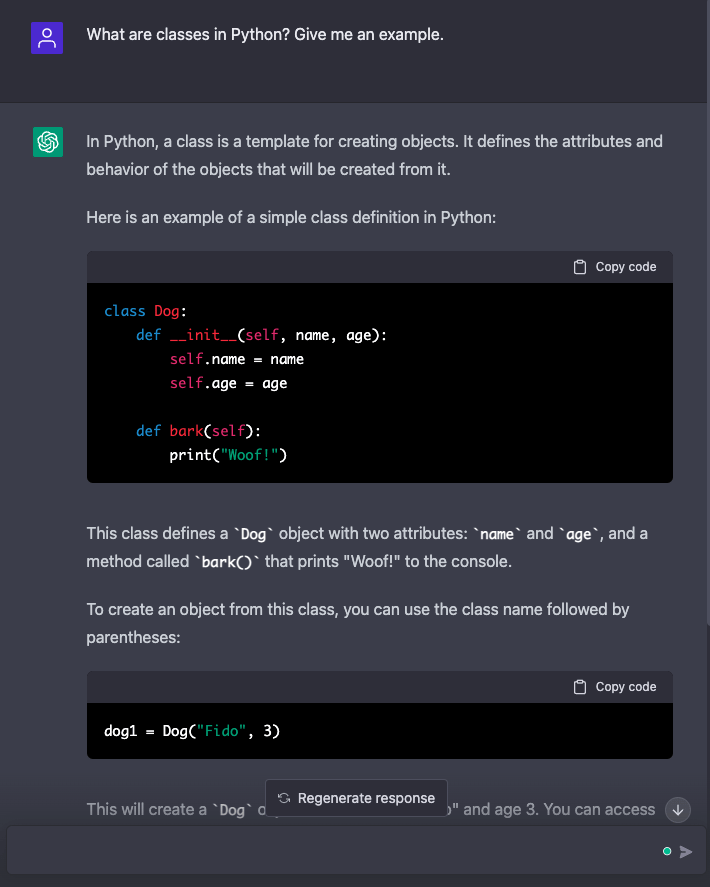
As a software developer, I can tell this code truly works and this explanation is great so that even a beginner coder could understand it.
And not only does ChatGPT code, but it can also help you understand how code works and help with issues in your code.
For example, here I’m asking ChatGPT to tell me what a piece of code does:
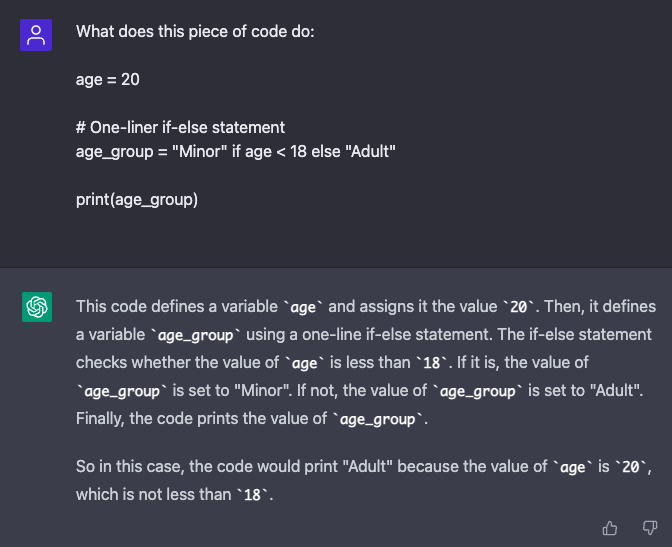
Here ChatGPT tells what the code does and even shows what happens if I run the code! Pretty impressive, I must admit.
Now there is pretty much an endless number of use cases when it comes to using ChatGPT.
A classical way to use an AI writing tool is to generate emails. Those lengthy emails that you need to write every now and then take a lot of time and thinking. Wouldn’t it be cool if the AI could do it for you such that all you need to do is tell what to include in the email?
Well, here’s an example. I asked AI to generate an email to a recruiter:
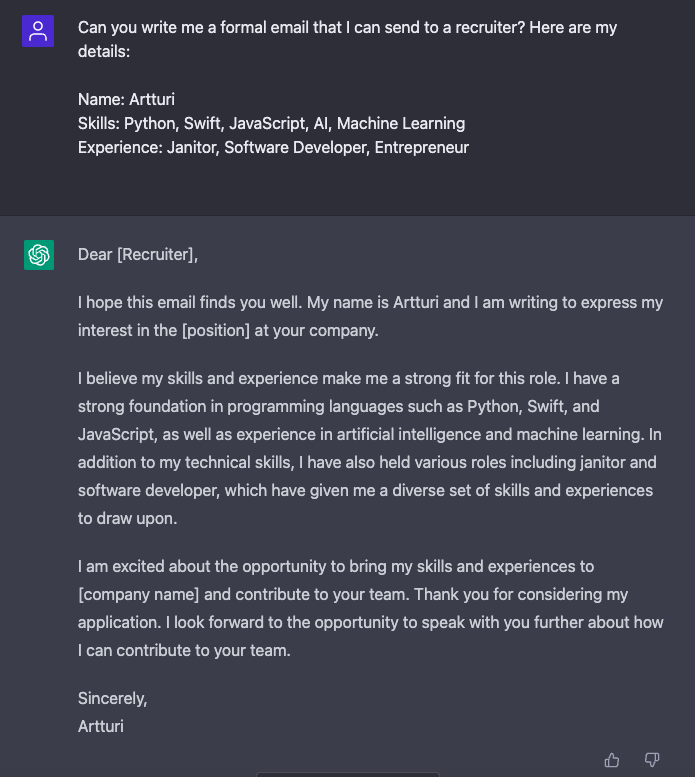
That’s a professional-looking email. All I need to do is fill the spots marked with [] before sending.
Chat History
One useful feature of ChatGPT is that you can now access earlier chats associated with your account. Out-of-the-box this was not possible, but because it’s such a useful feature, OpenAI added it no more than 2 weeks after the initial release.
For instance, here is the chat’s that I’ve had for making this review post:
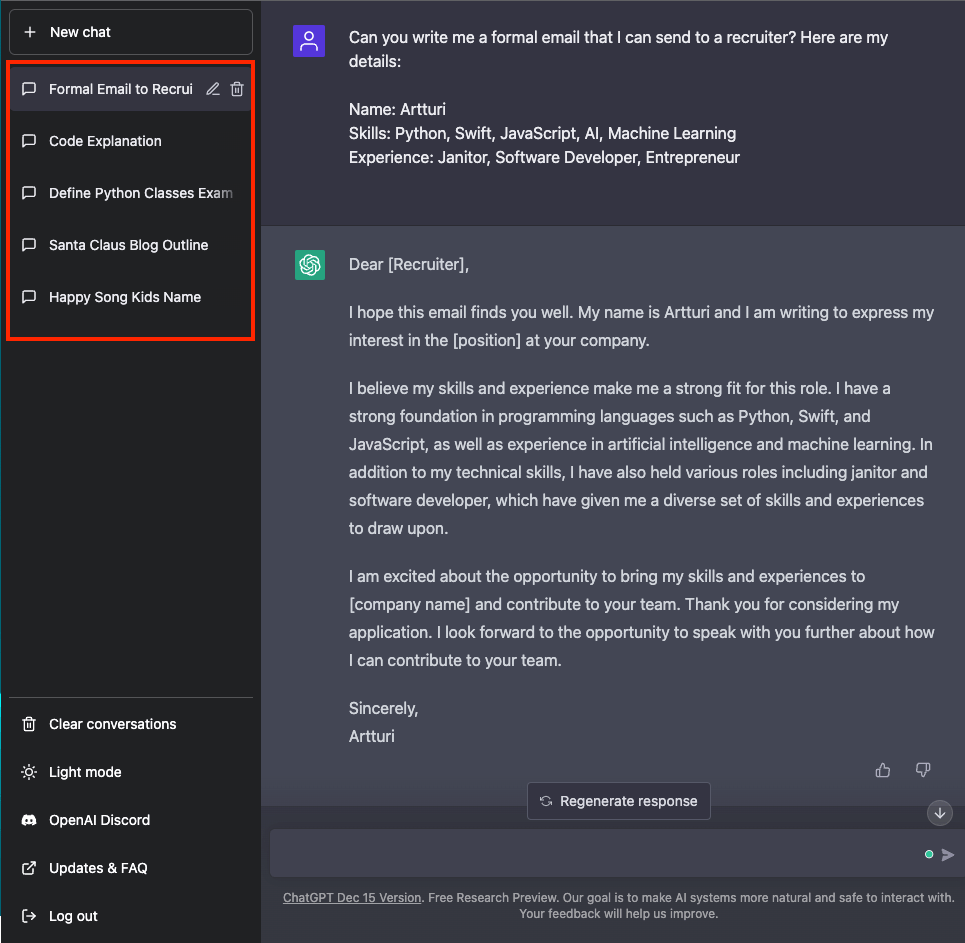
To access a chat, just click on one of the chats on the left. This also gives you the option to continue the conversation with AI.
Performance & Accuracy
ChatGPT performs really well when compared to a human writer. In terms of pure speed, the tool can generate a 500-word response (which at the moment is the maximum response length) in a matter of 30-60 seconds. Besides, ChatGPT doesn’t get exhausted so you can use it as much as you want.
But speed and performance are one thing, accuracy is another.
When it comes to accuracy, ChatGPT is awesome in well-known and well-researched topics. But add even slight depth to the topic and ChatGPT finds itself in serious trouble.
In my experience, ChatGPT can come up with nonsense answers and do it in a convincing manner. This makes it hard for you—especially if you’re new to the topic. This is why ChatGPT still needs human intervention and is not even close to a ready product.
Speaking of inaccuracies, let’s talk about the pros and cons of ChatGPT next.
Pros & Cons
Similar to any tool or algorithm on the market, ChatGPT has areas where it shines as well as big drawbacks and pitfalls.
In this section, you learn the most notable pros and cons of ChatGPT.
Pros
- User-friendly and easy to use, even for those with no technical experience, thanks to its intuitive interface. Just sign up and start using it like any other chatting service.
- Affordable writing assistant—the tool is free (for now at least).
- A fun tool for writers looking to boost their creativity and try out new ideas.
- Helps users generate new content and ideas, making it a useful tool for overcoming writer’s block and blank page syndrome.
Cons
- ChatGPT is not perfect and can make mistakes in its suggestions and corrections, so it’s important to double-check them for accuracy.
- While ChatGPT is a helpful tool, it cannot completely replace human writers and will require some human oversight to ensure the final product meets desired standards.
- 500-word message limit that limits text generation at one go (although you can just say “continue” if it stops)
- Occasionally repeats itself or suggests the same ideas or corrections multiple times.
- AI detectors are coming. With some AI detectors, you can already tell if the text is written by AI or humans. Make sure to read my writer.com AI content detector review to learn more.
- ChatGPT has learned from the internet. Thus, it can end up generating a piece of text very similar to an existing piece.
To highlight the last con, take a look at this piece of text I generated with ChatGPT. I asked ChatGPT to tell me who it is and here’s the result:
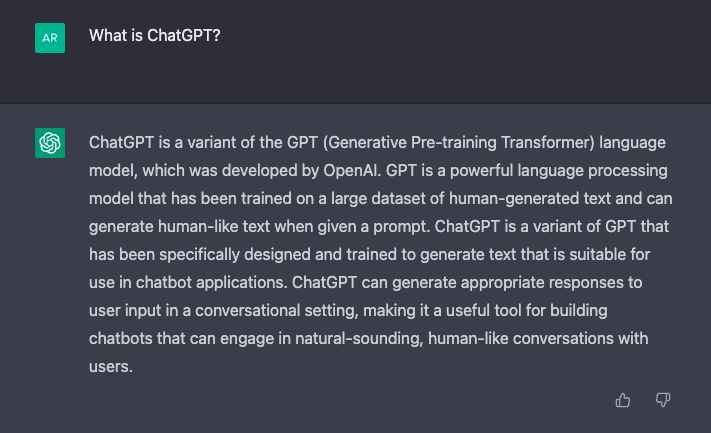
Looks good, doesn’t it?
But here’s the problem: The first sentence is direct plagiarism from an article published on Medium. (I used the free version of Duplichecker to check the content for plagiarism)
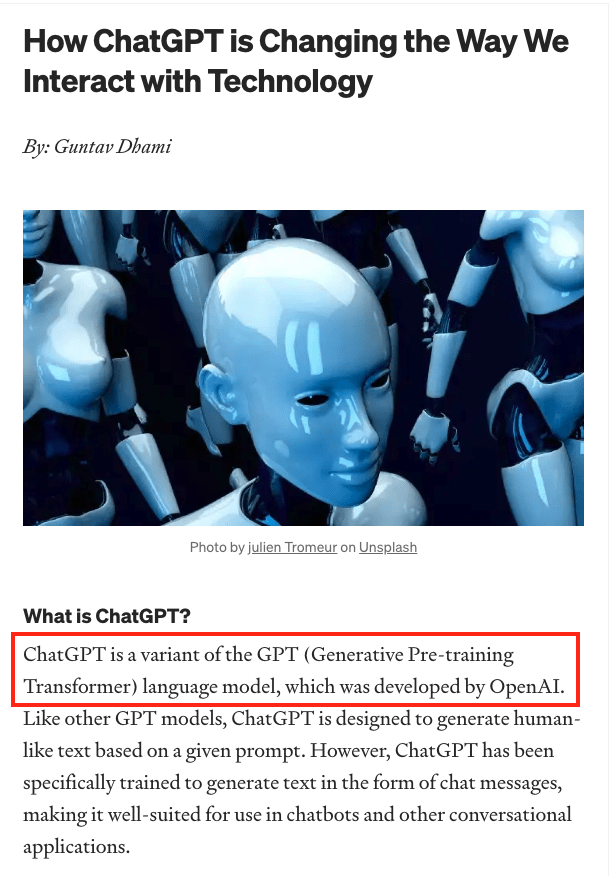
This is a big issue with AI-generated content. It’s most of the time unique but doesn’t guarantee that. If there’s not much information about the topic on the internet, chances are it can only present the idea in one or two very similar ways which leads to non-original content and even plagiarism.
That being said, you always need to make sure the AI-generated content isn’t plagiarised.
Summary
In conclusion, it’s clear that AI technology has come a long way, and AI writing tools like ChatGPT are increasingly useful.
However, it’s important to note that these tools are not yet able to completely replace human writers and still require some human intervention to ensure the final product meets desired standards.
ChatGPT is an impressive tool that is capable of writing both text and code, making it a versatile tool for a variety of use cases.
While ChatGPT has some major fallbacks that need to be addressed, such as the need for human oversight, it can still be a useful tool for writers looking to boost their productivity.
To get the most out of ChatGPT, it’s important to experiment with the tool and find new use cases and workflows that work best for you.
Thanks for reading. Happy writing!
